5 Christmas cactus problems to avoid
Get the lowdown on these Christmas cactus problems and keep your houseplants looking healthy and happy
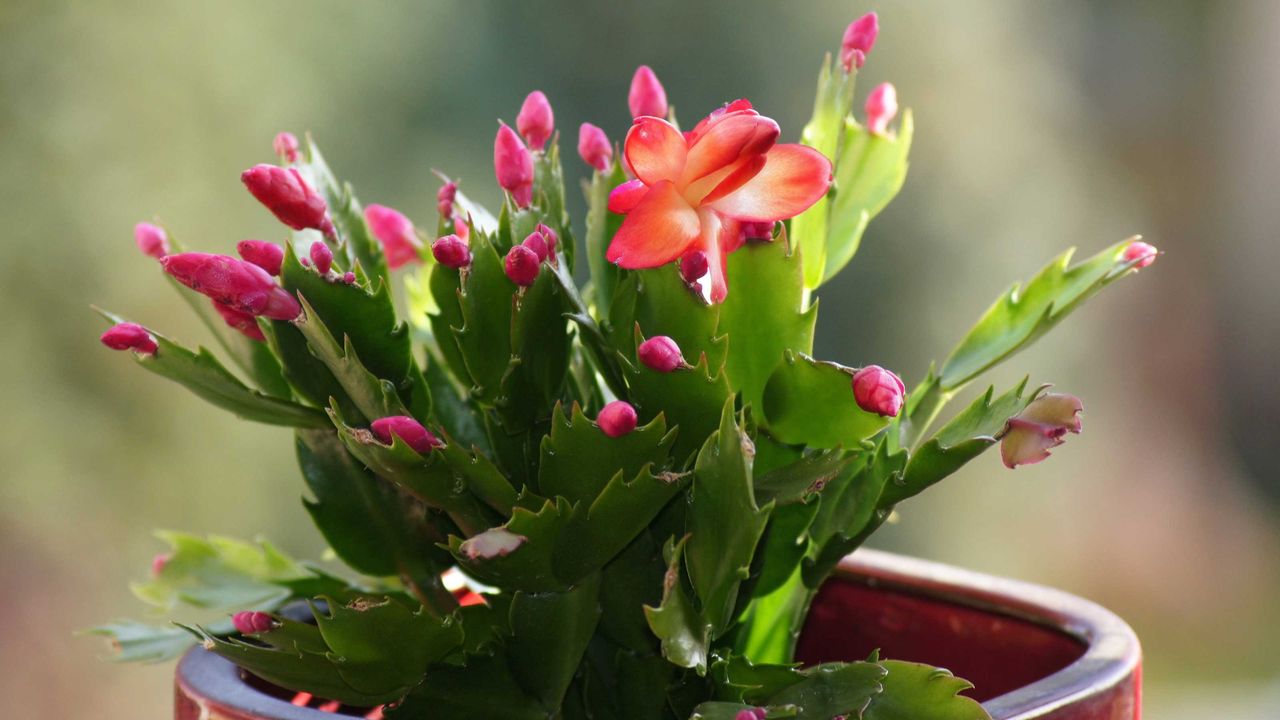


Are you pondering over some Christmas cactus problems? These houseplants are one of our favorites for brightening an interior during the colder months of the year, but their slight diva-ish tendencies mean they don't always grow how we'd like them to.
To put it plainly, Christmas cactus care requires a bit of know-how, and as a result, there are a few issues that are quite common when growing these plants. So, if your succulent looks shriveled rather than stunning, has failed to flower, or has dropped its leaves seemingly at random, don't despair. Our guide explains what to do.
5 Christmas cactus problems to look out for
Don't let these Christmas cactus problems put you off – once you know how to avoid them, they make fabulous Christmas plants.
1. Snapping stems and dropping leaves
If the stems of your Christmas cactus are snapping, meaning whole sections are being shed, too much water is probably to blame.
Overwatering houseplants is nearly always problematic and often leads to rotting. So, to avoid this issue, improve your Christmas cactus watering routine by only watering when the top of the compost feels dry. Ensuring the container has drainage holes, and mixing grit into the soil when you plant it, can also help.
Remember, too, that these plants need to go through a resting period from mid-winter to late spring. During this time, water less than you would the following summer, which is when the plant will enter its growing phase again.
In early fall, they enter a second resting period, which is when the buds begin to develop, explains the experts from Amateur Gardening magazine. Again, reduce watering slightly during this time, until the buds have formed.
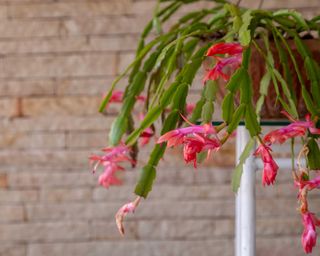
Provide the right care and you can avoid most common Christmas cactus problems
2. A lack of flowers
One of the reasons these indoor plants are so popular is their vibrant flowers, ranging in color from bright red and pink to elegant white. It's no surprise, then, that one of the most disappointing Christmas cactus problems that can occur is a lack of blooms altogether.
To get a Christmas cactus to bloom, the plants need the two resting periods explained above. John Negus, an expert from Amateur Gardening, points out that monitoring the temperature during the second resting period is particularly important for encouraging blooms. Temperatures of 65°F (18°C) or above will be too warm during this time, and as a result, they 'inhibit flower initiation, delay the onset of flowering, and reduce the length of the plant’s flowering period,' he says.
'When the flowering buds have formed, increase the temperature back to 18-20°C (65-69°F).
'Your plant should then flower and give you a wonderful display,' he says. 'Exact temperatures are not critical to promote flowering, provided your plant has two resting periods with a reduction in watering and temperature.'
If your Christmas cactus has failed to flower, you can try repotting it in cactus compost and positioning it in light shade, says Christine Walkden, also of Amateur Gardening magazine. 'It is not happy in deep shade or bright, hot sunlight.
'Clean its leaves, to help them breathe better, by dabbing them with a kitchen towel soaked in milk,' she adds.
John also suggests feeding it with a high-potash tomato fertilizer – available on Amazon – when it is showing flower buds to encourage the blooms.
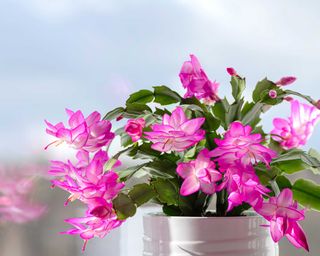
Christmas cacti are favored for their beautiful blooms
3. Buds falling off before blooming
If flower buds are falling from your plant, rather than entire sections of stem, you are likely under-watering your plant.
These houseplants love humidity and need moisture to stay healthy. In fact, if you're also wondering why your Christmas cactus is wilting, a lack of water can be to blame.
Use rainwater collected from the garden when watering, and don't let the soil dry out completely. Improve the conditions and your plant may revive, with the leaves plumping back up again after a week or so.
Flower buds dropping can also be put down to sudden changes in temperatures, says Jo Lambell, Founder of Beards & Daisies. 'During the growing season, it's best to maintain a temperature of 64.4-68°F (18-20°C).'
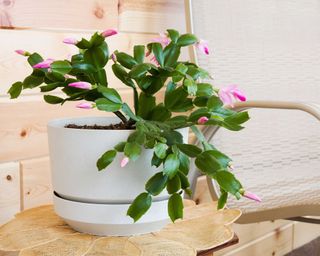
Getting your watering routine right is essential for these houseplants
4. Discolored foliage
Have you noticed your Christmas cactus' leaves turning pink?
'Discoloring happens when the Christmas cactus is exposed to too much light,' explains Jo. 'Remember, these cacti are different from desert cacti and are used to dappled light as they grow naturally in rainforests.'
As they do best in a semi-shaded space, it might be time to rearrange your indoor garden.
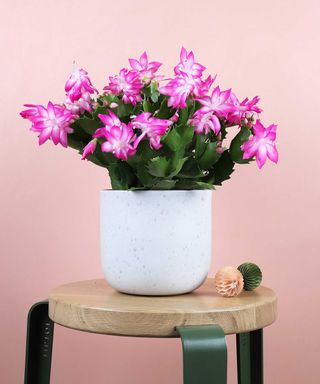
The Christmas cactus, available at Beards & Daisies, will brighten up your home over winter
5. Lackluster growth
If your Christmas cactus is generally looking a little worse for wear – despite correct watering, positioning, and temperature – it might be an issue with the container it's planted in.
The RHS explains that over-potting – that is, repotting a Christmas cactus in a pot that's too large – can cause poor growth. A good way to check is by carefully removing the pot and inspecting the roots. If there is no sign of obvious new growth, gently brush away excess soil and repot it into a smaller container. This action should encourage new root growth and recovery, they explain.
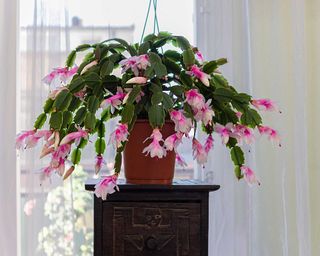
Christmas cacti like a snug fit in a pot
How do you regenerate a Christmas cactus?
Even if you avoid the Christmas cactus problems above, after a good few years these plants can start to decline. But, it's possible to regenerate them and give them a new lease of life.
'Remove any obviously dead shoots and shorten it to within 6in (15cm) of the base,' says John Negus. 'Then, repot it in loam-based ericaceous compost, augmenting it with a quarter part, by volume, of coarse grit. Water it in with clean rainwater.
'Finally, position it in light shade to simulate its natural habitat. Within three or four weeks, new shoots will proliferate from the woody stock to create a fine new plant.'
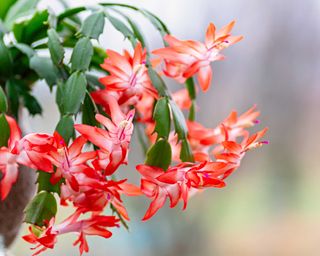
After a few years, you may wish to regenerate your Christmas cactus
What are the white threads in the compost of my Christmas cactus?
'The white "cobwebs" covering the compost are questing mycorrhizal strands that live symbiotically and beneficially with the plant’s roots,' explains John.
However, if you have noticed a whiteish-grayish mold on the leaves and stems of your plant, it has likely caught botrytis blight – a fungal disease. Sadly, the best course of action is generally to destroy the plant – and quickly, before the problem spreads to any of your other indoor plants. However, in mild cases, it may be worth removing the affected areas first, in an effort to save it.
Improving ventilation and reducing humidity so it's not excessive can help keep this problem at bay.

The garden was always a big part of Holly's life growing up, as was the surrounding New Forest where she lived. Her appreciation for the great outdoors has only grown since then. She's been an allotment keeper, a professional gardener, and a botanical illustrator – plants are her passion.
-
 An Update on Gardeningetc
An Update on GardeningetcA word from our publisher
By Beth Murton Published
-
 Do you need to chit potatoes? Find out what the experts say
Do you need to chit potatoes? Find out what the experts sayGrow Your Own Learn how to chit potatoes before planting them in the ground and you’ll be on your way to getting an earlier and bigger harvest
By Drew Swainston Published
